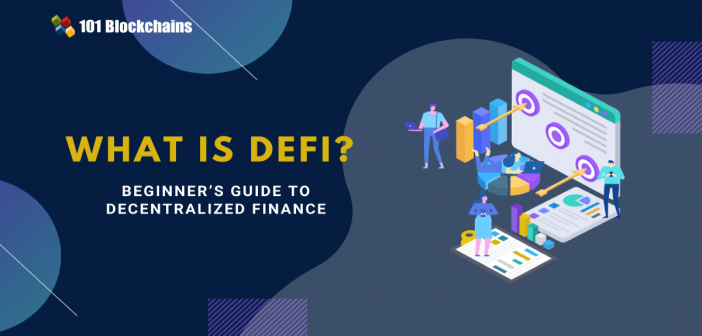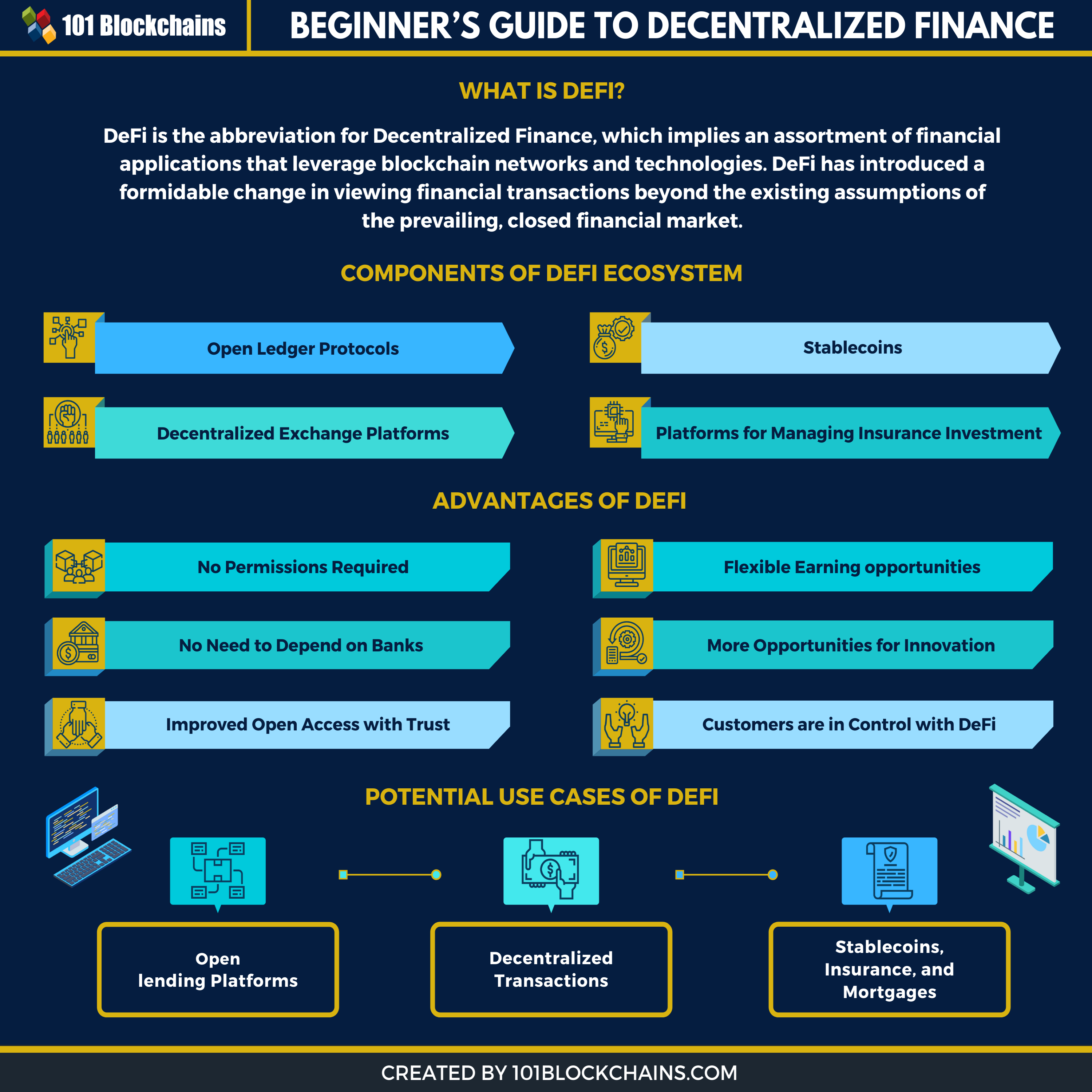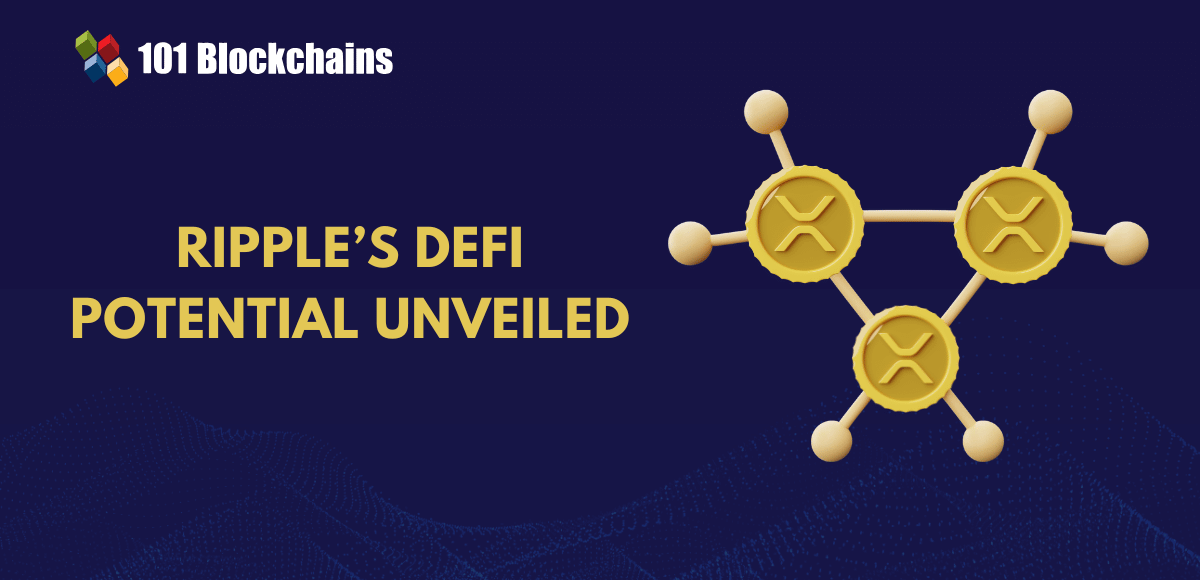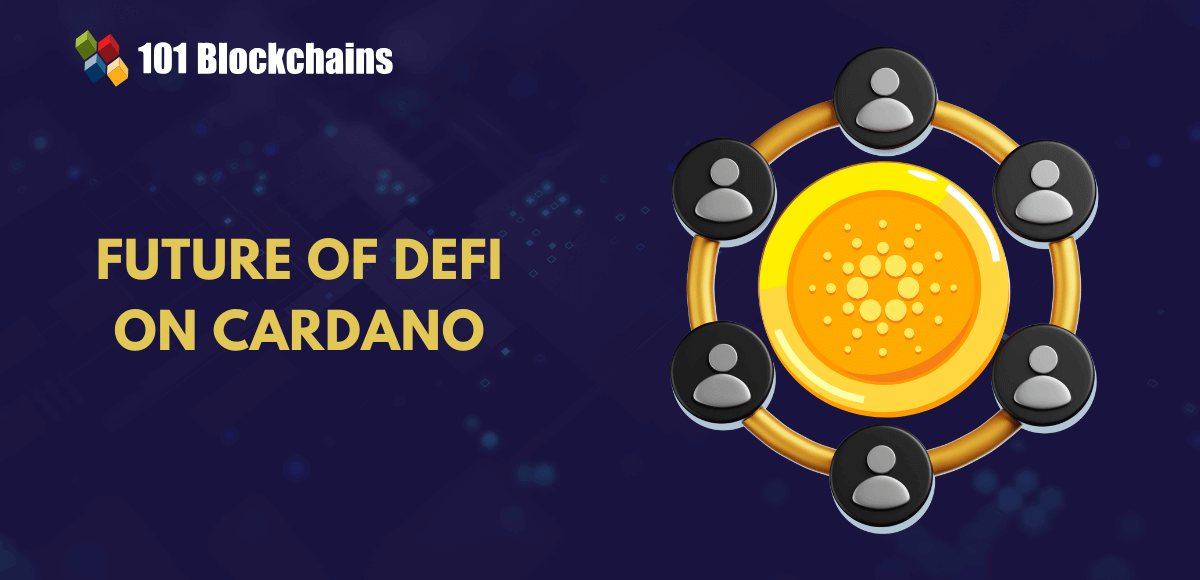Learn how blockchain truly works, master key definitions, and uncover what makes smart contracts so "smart." Dive into the fundamentals, gain valuable insights, and start your blockchain journey today!

- Decentralized Finance
Gwyneth Iredale
- on October 17, 2020
What is DeFi – Beginner’s Guide to Decentralized Finance
Decentralized Finance (DeFi) has become a buzzword that has introduced a formidable change in the approach about financial transactions. If you are a beginner, read this definitive guide to Decentralized Finance and understand what is DeFi.
Money has been an inevitable aspect of the progress of human civilization since ancient times. Apart from providing a viable instrument to foster financial transactions, money has been a significant symbol of the trust between two parties involved in a specific transaction. The assurance of a tangible commodity for different transactions with money is a formidable reason for which it is practically impossible to think of a world without money.
Cryptocurrencies are taking the world by storm with anticipations suggesting that money, as we know it, might be nearing its end. At this time, one question- ‘what is DeFi” has been gaining prominent attention, in particular. DeFi, or Decentralized Finance, is gradually gaining momentum as one of the hot topics of discussion. The formidable demand for DeFi developers is also one of the reasons for drawing attention to decentralized finance.
So, let us reflect on the meaning of DeFi and insights for understanding DeFi Ecosystem in a simple and better way. The following discussion not only focuses on DeFi meaning but also on the factors that led to the origin of DeFi. Beginners can use this discussion to establish a foundation-level knowledge regarding decentralized finance, beyond the scope of a mere DeFi overview.
Want to learn and understand the scope and purpose of DeFi? Enroll Now in Introduction to DeFi- Decentralized Finance Course
Definition of DeFi (Decentralized Finance)
Almost every beginner would wonder about ‘what is DeFi’, and it is reasonable. DeFi is the abbreviation for Decentralized Finance, which implies an assortment of financial applications that leverage blockchain networks and technologies. Decentralized Finance or DeFi has introduced a formidable change in viewing financial transactions beyond the existing assumptions of the prevailing, closed financial market.
The potential of DeFi is tailored for shifting the attention towards a financial economy with better transparency. In the supposedly new, open financial economy, financial protocols would rely on three dominant elements: interoperability, programmability, and ease of composing. Decentralized Finance is the architect and leader of the Open Finance movement.
With the Open Finance Movement, users can find alternatives for financial services such as savings, insurance, loans, trading, and many other significant financial activities. The prospects with DeFi applications are expected to surpass the conventional, closed financial applications in terms of scope and reach. First of all, DeFi presents better chances for accessibility to every individual having a two-core dependency.
Two-core dependency implies internet connectivity and devices for accessing a service, such as a computer, smartphone, or tablet. The most crucial factor in an introduction to DeFi would refer to the possibility of leveraging Ethereum for the integration of cryptocurrency, financial systems, and blockchain technology efficiently. Therefore, it is easier to understand that DeFi capitalizes on the existing financial market to ensure better transparency and feasibility of editing for different protocols.
Learn the fundamentals of Decentralized Finance (DeFi) with DeFi Flashcards
Purpose of DeFi (Decentralized Finance)
The next crucial concern for any individual after learning about what is Decentralized Finance is the purpose it serves. It is reasonable to wonder about why DeFi came into existence, and this question becomes quite inevitable in times when decentralized finance is being termed as an unstoppable phenomenon. Therefore, a closer reflection on the origins of DeFi can shed light on what is DeFi and why we need it.
The centralization factor in the traditional marketplace is an evident detail with the influence of governments, also centralized in terms of structure. Therefore, the currency system is also supposed to function through centralized entities such as banks. The centralization factor implies the management and regulation of centralized entities, with absolute control vested in the entities.
Furthermore, a centralized approach also implies higher risk due to the single point of failure. Many questions about the functionalities of centralized entities also create the need to focus on alternatives. For example, the timing of decisions by authorities for printing more currencies and the impact of factors such as financial need or the need for continuity on such decisions are some of the questions that create doubts about the long-term potential of centralized finance systems.
Want to explore an in-depth understanding of security threats in DeFi projects? Enroll in DeFi Security Fundamentals Course Now!
How did Decentralized Finance Come Into Existence – Origin of DeFi
The understanding of the origins of DeFi takes you beyond the simple answers to what is DeFi. Let us take the example of dollars to understand the pitfalls in centralized entities. The continuously declining value of dollars over the last 50 years shows that it had comparatively higher purchasing power than that in 2020. The inflation in currency value requires you to have more currency for purchasing the same product that you could have purchased in the past.
The example of Venezuelan government’s bad monetary policies and their impact on an all-time high inflation rate draws attention towards the setbacks of centralized entities. The government further exacerbated the situation through decision to print more currency in event of a drop in oil price. As a result, the 1,000,000% inflation rate created a drastic imbalance in Venezuela’s economy. Banks are also one of the critical factors that have a role in fostering the idea of Decentralized Finance.
Almost all banks provide interest on the savings of a customer in the form of recurring or fixed amounts. However, banks utilize the money of customers for investment in different markets through loans to businesses at higher interest rates. As a result, banks gain larger profits from the money of customers while returning a trivial fraction of the profit to the customer.
Annual interest rates worldwide are poised at 2-3%, thereby indicating that customers don’t get the benefits they want by depositing their money in banks. Therefore, customers should find ways to diversify their investments in the share market, schemes, mutual funds, and many other financial instruments. At this point, the importance of what is DeFi becomes evident as banks don’t allow control for customers to diversify their investments.

Common Use Cases of Decentralized Finance
Decentrlized Finance emerged as a favorable solution for the setbacks mentioned above in conventional centralized financial systems. It not only takes away the need for central authorities in financial systems but also re-inventing the banking system for providing opportunities to almost every individual. An in-depth reflection on the use cases and benefits of DeFi can help you anticipate the reasons to focus on what is DeFi. Here is an outline of the different common use cases of DeFi.
-
Open Lending Platforms
The open-source nature of DeFi facilitates exceptional opportunities for open lending protocols. The open lending protocols improve the ease of lending activities in Decentralized Finance. Open lending protocols ensure the collateralization of digital assets, standardization, zero credit checks, and instant transaction settlement.
Furthermore, the hosting of lending services on public blockchains ensures adequate trust in the functionality of these systems. Additionally, the support of cryptographic verification methods, limited counterparty risk, and cost-effective process make Decentralized Finance lending services better than conventional credit systems.
-
Decentralized Transactions
The use cases of DeFi in a decentralized marketplace also offer prospects for emphasizing on what is DeFi. Decentralized marketplace or DEX platforms remove the need for centralized authorities for holding digital assets for trading. However, centralized marketplaces hold absolute control over digital assets with a central point of failure, thereby increasing the chances of exploitation by hackers. In a DEX platform, the use of smart contracts for automation of trade and other trading tasks reduces the cost and improves trust.
-
Stablecoins, Insurance, and Mortgages
The use of DeFi for insurance, mortgages, and stablecoins is also another promising example of the emerging common use cases of DeFi. Decentralized Finance provides an ideal basis for fostering the use of the stablecoins market in terms of value concerning fiat money. Decentralized Finance supports insurance activities by removing intermediaries and speeding up the process efficiently. Subsequently, Decentralized Finance could also promote speed and cost reduction in mortgage solutions by leveraging smart contracts.
Want to learn the basic and advanced concepts of Stablecoin? Enroll in our Stablecoin Fundamentals Course Now!
Advantages of DeFi (Decentralized Finance)
Now, the next important concern in understanding Decentralized Finance DeFi refers to its benefits. Although there are multiple advantages of DeFi, let us focus on the important mentions that foster the popularity of Decentralized Finance.
-
No Permissions Required
Decentralized finance presents critical advantages with its permissionless nature. Permissionless finance improves access to financial services and products for people who cannot access centralized finance. At present, 20% of the global population cannot access banking solutions due to various factors. Lack of proper documentation, lack of banking solutions in the geographic location, or bad credit score are reasons that restrict access to banking services.
DeFi takes away these issues and the DeFi decentralized application, MakerDAO, is the perfect example. MakerDAO helps in leveraging Ethereum (ETH) for taking loans. You can deposit ETH on the MakerDAO platform that relies on an automated smart contract solution to manage the complete process. The smart contract enables creating a Collateralized Debt Position (CDP), which helps in obtaining DAI crypto coins.
-
Flexible Earning Opportunities
The next important benefit of Decentralized Finance that draws attention to what is DeFi is the ability to earn money. Many decentralized apps such as Compound and Dharma allow for driving additional value to the investments in digital assets. These apps can help in utilizing digital assets like DAI or USDC that, in turn, are allowed for other users to borrow. As a result, customers can obtain a better interest in comparison to conventional banking systems.
-
No Need to Depend on Banks
The facility of improved accessibility in DeFi, in comparison to capital and services, is also a formidable benefit. DeFi takes away the need for dependence on the government’s banking systems, thereby drawing attention towards what is DeFi and why do we need it.
-
More Opportunities for Innovation
The DeFi ecosystem provides credible prospects for innovation and creation of DeFi services and products. DeFi is an open protocol and can be formidable support for developing a new generation of financial solutions. The DeFi meaning garners higher importance as it can leverage Ethereum and allows innovators to create new decentralized apps for the financial sector.
-
Improved Open Access with Trust
Transparency is also one of the crucial highlights in the introduction to DeFi, thereby implying towards prospects for testing and trying DeFi apps solutions with ease. Transparency also enables the assurance of a trustless system with ease of use.
-
Customers are in Control with DeFi
The most critical benefit of DeFi that signifies the need to focus on what is DeFi is the absolute control for customers. Customers can gain complete control over their finances with DeFi, with the flexibility to take decisions about their investments. Therefore, DeFi enables prospects to achieve better interest rates depending on the place of investment.
Want to learn about DeFi applications and how these work? Check here the Top 5 DeFi Applications Presentation Now!
Components of the DeFi Ecosystem
With the understanding of what is DeFi and its importance based on its various use cases and benefits, it is reasonable to think of the overall DeFi ecosystem. The best DeFi projects and a detailed impression of the DeFi ecosystems can help in topping up your understanding of DeFi fundamentals effectively.
The vast DeFi ecosystem contains crucial elements such as open ledger protocols, stable coins, exchange, and open marketplaces, and insurance and investment management platforms, which we have reflected briefly in the earlier parts of this discussion. Speaking of the best DeFi project in common application, MakerDAO comes to the forefront. Let us find in-depth insights into the components in the DeFi ecosystems to understand how it has given rise to many helpful apps that change the way we used to look at financial systems.
-
Open Ledger Protocols
Open ledger protocols gain prominence in the DeFi landscape due to its open-source nature. The popularity of DeFi projects such as Compound Finance, DAI, or Dharma implies the efficiency in open ledger protocols. The platforms mirror the functions of real banks, allowing users to deposit assets that the system utilizes for borrowing and lending.
The flexibility of DeFi landing platforms is formidable support for achieving better returns on investments along with the assurance of improved control on your investments and returns. The support of smart contracts in automation of lending and borrowing activities in DeFi projects is also a favorable aspect. For example, smart contracts help connect lenders and borrowers, interest management, and documentation of loan terms.
Additionally, you also get the benefit of transparency and removal of central authorities to ensure higher returns with a better understanding of investment risks. Open ledger protocols are an important aspect of understanding DeFi and how public blockchains like Ethereum can help in standardization and global recognition of protocols. As a result, you can find many other benefits of a public blockchain like Ethereum with open ledger protocols.
Some of the notable benefits include the collateralization of digital assets and the integration of digital asset lending and borrowing. The benefits of standardization and interoperability and automation are also evident. You can also notice the benefits of faster and instantaneous transaction settlement through secure lending methods. The limited requirement of KYC or credit checks for accessing financial services with open ledger protocols also present credible advantages.
It is important to understand the risks in DeFi to discover its potential from a neutral perspective. Here’s a guide to Risks in DeFi and how to manage them.
-
Stablecoins
Stablecoins are formidable components for understanding DeFi ecosystem, as they are compared in terms of value of real-world currency assets. Generally, all stablecoins in the existing DeFi ecosystem are pinned against the US dollar. The primary objective is to ensure better performance, trust, and stability.
The design of stablecoins for maintaining stability compared to cryptocurrencies is also a striking highlight for the DeFi ecosystem. Stablecoins are classified into three different categories, such as fiat-collateralized, non-collateralized, and crypto-collateralized stablecoins with distinct traits and functionalities. Fiat-collateralized stablecoins are pinned against a real currency like US dollar or Euro, thereby providing better assurance of stability.
The same ratio comparison with fiat currency ensures better stability and non-volatility with stablecoins. The commonly accepted fiat-collateralized stablecoins refer to Gemini Dollars, Tether, USDC, and many others. Fiat-collateralized coins also come with certain risks, especially with the requirement of a centralized authority.
Also, you need proper regulations for maintenance and adoption of stablecoins among the general public. Crypto-collateralized stablecoins are similar to fiat-collateralized stablecoins with cryptocurrencies replacing fiat currency. The primary factors that drive stability of crypto-collateralized stablecoins include utility incentives and trustless insurance. One of the prominent examples of crypto-collateralized stablecoin refers to DAI.
Crypto-collateralized stablecoins depend on collateralization, only when the stablecoin slips to debt. The volatility issues with crypto-collateralized stablecoins find a reliable answer by enabling the protocol with lender capabilities. The last type of stablecoins is non-collateralized stablecoins. The striking highlight of non-collateralized stablecoins is the underlying algorithm driving the development of additional tokens. It works in event of the need for ensuring the reduction of token value and maintaining stability.
-
Decentralized Exchange Platforms
Decentralized exchange or DEX platforms are critical additions in answers to what is Decentralized Finance and the DeFi ecosystem. IDEX is a prominent example of a decentralized exchange. These platforms offer better accessibility to users through partial identity disclosure.
Also, the decentralized exchanges take away the need for storing digital assets. Users should connect their wallets to the exchange and wait for the execution. After the initialization of the trade, smart contracts ensure proper management of the transfer of funds.
-
Platforms for Managing Insurance Investments
DeFi ecosystem also presents promising opportunities for better investment and insurance platforms. The security token market plays a crucial role in speeding up insurance activities. Polymath is the perfect example of one of the best DeFi projects in this case.
It provides better tools, frameworks, and resources for the creation, management, and publication of security tokens. Many other asset management platforms can also help in better management of trading and risk management.
Build your identity as a certified blockchain expert with 101 Blockchains’ Blockchain Certifications designed to provide enhanced career prospects.
Final Words
On a final note, you can notice that Decentralized Finance is the next big thing in revolutionizing financial systems. Learners have the opportunity of uncovering an array of information that showcases its importance in the existing financial landscape. DeFi also presents reliable prospects for the digital transformation of financial systems and improving access to financial instruments with ease.
The growing need for overcoming challenges with traditional financial systems will continue to foster the growth of DeFi ecosystem. So, it is reasonable to anticipate career opportunities with DeFi skills and choose trustworthy learning platforms for career growth. Enroll in DeFi course and take the first step towards learning about Decentralized Finance right now!
*Disclaimer: The article should not be taken as, and is not intended to provide any investment advice. Claims made in this article do not constitute investment advice and should not be taken as such. 101 Blockchains shall not be responsible for any loss sustained by any person who relies on this article. Do your own research!



![30+ Best Decentralized Finance Applications [Updated] best decentralized finance (DeFi) applications](https://101blockchains.com/wp-content/uploads/2020/10/decentralized-finance-applications.png)

